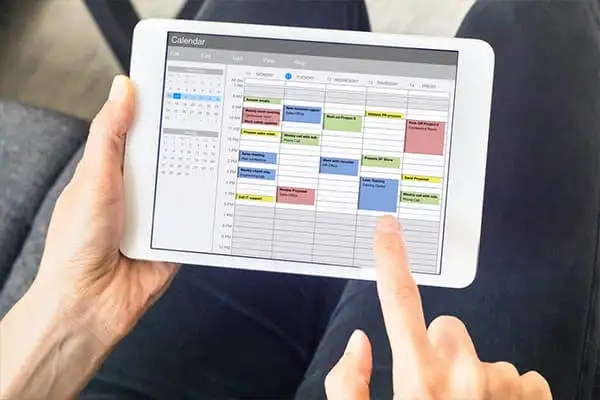If you’re new to working from home, this expert how-to guide will help you set your workspace up right.
The global shift to remote work has been going on ever since the internet and smartphones became commonplace, and it’s rapidly accelerating. But what’s the best way to set yourself up at home to accomplish all the same tasks you got done when you commuted to the office? How do you maintain efficiency, avoid distractions, manage time, and cope with the added social isolation that comes with working remotely?
As a freelance writer, I’ve been working remotely for nearly a decade, both at home and abroad. Here are my tried-and-tested tips for setting up a remote office, whether your new workspace is a spare room in your own house or a cozy apartment in a distant land.
Getting Started

Remote work can be occasional or full-time. Either way, you’ll need a few essentials: a computer, a stable internet connection, a phone, and a comfortable table and chair. A decent chair is important, since you’ll be spending a lot of time at your new desk. If your set-up isn’t suitable for long periods of use, your health and productivity will suffer.
According to one study, an ergonomic chair with quality lumbar support can increase overall productivity by up to 18%—so if you don’t own one, go out and order one online.
Internet speed requirements will depend on the kind of work you do. If your job entails video conferencing, high-end graphics, live streaming, advanced editing systems, or regular downloading of bulky files, you’ll require more online ‘juice’ than someone whose workday is limited to Word documents, email, spreadsheets, and the occasional Skype chat.
Generally speaking, if your computer can handle smooth streaming of your favorite Netflix shows, it can cope with remote office work. Insider tip: Ethernet offers a more reliable and secure connection than Wi-Fi, which is more susceptible to interference.
If your employer already uses a VOIP (Voice Over Internet Protocol) service, you can get work-related phone service through the Web instead of paying for it via the phone company.
If you have a spare monitor available, use it. Having two screens works well when you’re conducting research, comparing documents, or juggling multiple programs or pages. And don’t discount the value of old-school pen and paper: you should always have a notebook at your elbow to jot down ideas and reminders.
If you find you work better while standing up or sitting on a stability ball, do that. There’s no law against a change of scenery, either: work for a couple of hours from your kitchen table, then drag your laptop to the local park for a bit, then return home to the designated workspace in your study.
Some people work better amid the buzz of a busy café or co-working space, while others perform best in a library or their own dining room. I’ve worked successfully from my back patio at home and in Airbnb apartments abroad for years. Only you can determine your ideal work environment.
Minimize distractions. Make sure your family understands you should only be disturbed during break times. Separate your work space from household noises and activities as much as possible. Create well-defined boundaries that family and online work colleagues will appreciate and respect.
A remote office needn’t be a sterile space. Personalize it with attractive house plants, an inflatable footrest, a comfy rug, family photos, and anything that makes you smile or feel more energized.
Time Management

Working remotely requires discipline. Procrastination is your enemy. Stay productive by establishing a daily routine you can live with. Communicate with your boss, work colleagues, and clients regularly and often. You should always know what’s expected of you and discuss problems as they arise. A brief call with relevant co-workers/clients at the start of each day sets a clear path for the tasks to follow.
Online communication platforms such as Slack, Zoom, Basecamp, and Skype can help you and your colleagues stay on the same page as projects develop. Apps can also track the online hours you’re working.
Keeping communication lines open and active has an important side benefit: it reduces the loneliness that’s one of the main drawbacks of working on your own. Without the social feedback and personal interactions enjoyed in a traditional office, you may feel unstructured, isolated, and lacking in motivation.
Staying in the office loop with consistent communication means you’re not ‘out of sight, out of mind’; you still feel you’re a vital part of the team. Video calls are a great way to keep face-to-face interactions going and maintain high spirits during long remote working spells.
Always start your remote workday at a specific time, every time. Take a shower, get dressed, have your morning coffee, and treat it just like a normal job. Take regular breaks—your eyes, back, and neck will thank you. Don’t eat at your desk: schedule a proper lunch hour. Set up a yoga mat, a treadmill, or a stationary bicycle nearby if you want to exercise during quick breaks.
Organize work patterns to align with family obligations and your own body clock. If you’re a morning person, get the most vital work done before lunch. If afternoons are your high-energy times, structure the workload accordingly. Resist the temptation to work past 5 p.m.—have a standard afternoon shut-off point where you officially end the workday.
Remote work comes with its own unique challenges, but there are also proven benefits. These include reduced office politics, diminished stress associated with commuting, and fewer interruptions from workmates and management. Taking control of your own work time and environment can be empowering, and provides a level of flexibility that’s hard to come by in most traditional work spaces.
Tools and Tips for Remote Workers

If your remote office needs to be 100% portable, there’s obviously a limit on how many ‘essential office supplies’ you can fit into your suitcase. In my case, a solid-state laptop (with spare battery), mobile phone, headphones, external hard drives, USB sticks, and a notepad are just about all I need. I communicate with clients through email and Skype, and use a variety of online apps to perform specific tasks as needed.
If you have the advantage of setting up a remote office at home, you can create the work station of your dreams and include whatever you like. Here are just a few additions that can make life easier and help you stay more productive:
A Decent Set of Speakers –
Mood music can help you relax and stay energized throughout the day, and also washes out ambient distractions to keep you focused. Wearing headphones for hours on end isn’t ideal, so invest in a quality set of office-ready speakers. Dig into your instrumental and chill-out playlists to set the right tone for ‘serious work mode’.
The Best Light –
Natural light makes a workspace feel brighter and happier, so open your blinds and let the sun shine in. A soft, glowing desk lamp can create a mellower work environment too; avoid harsh fluorescent tubes. Don’t make computer screens your main light source—if your remote office is too dimly lit, you’ll suffer eyestrain, headaches, and fatigue.
Procrastination Busters –
One of the most difficult challenges of working remotely is staying motivated and productive. For some workers, remembering to take regular breaks is a problem. For others, procrastination is the main issue.
The Pomodoro Technique can be a useful time management tool. Using a timer, you break down your work into set intervals, separated by short breaks. For example, you might work solidly for 25 minutes, then break for three to five minutes. Choose the schedule you find works best for you (I prefer a 10-minute break every hour, with a 45-minute lunch to slice the day in half). It sounds simple, but the structure is a constant reminder of time and how you’re using it.
If you’re easily distracted by social media, emails, or online games, download an anti-procrastination app that will block specific sites for selected periods while you work. There are dozens to choose from, including Toggl or Offtime.
App it up –
Most of the online applications you use in a normal office can be used remotely, so you won’t need to download much new stuff when you go remote. Probably the biggest change will be in how you communicate. Standard workplace interactions and chats will be replaced with phone calls, video link-ups, virtual conferences, and online product management tools.
Evernote, LastPass, Trello, HelloSign, and Toggl are just a few programs I’ve found useful in my own work to streamline efficiency. The bottom line: any app that helps you save time, reduce stress, or boost productivity is worth looking into.
Remote offices are the way of the future, whether you’re working from home, a local café, or a beachside unit on an exotic Mediterranean island. Making them work is all about being prepared, understanding the challenges and embracing the positives—so you can continue to do your very best work.
Related Articles
5 Top Spots to Start Your Digital Nomad Journey
What Do You Need to Teach English Online?
This Online Freelancing Role Is Tailor-Made for Baby Boomers
